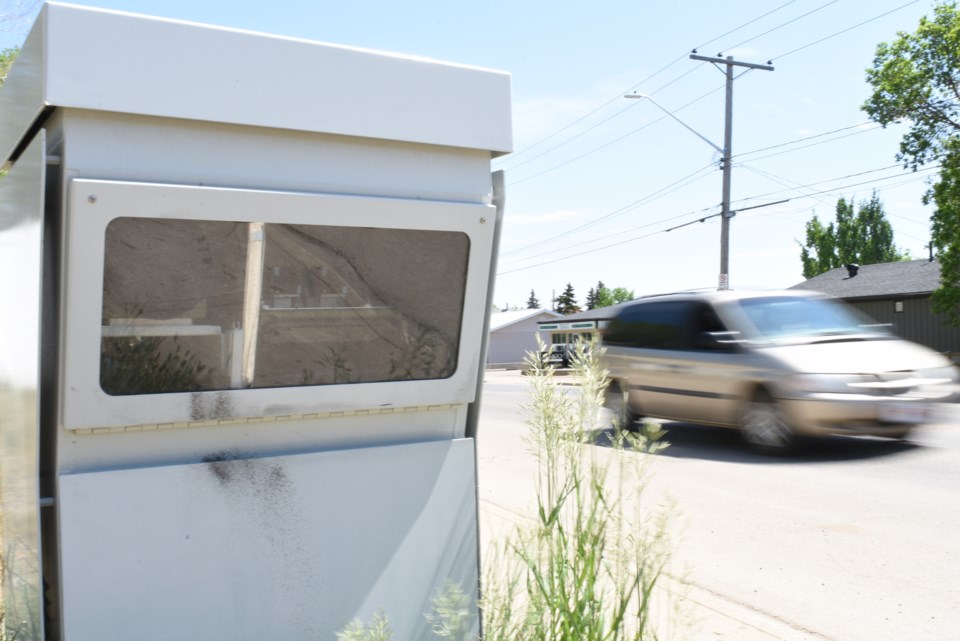The financial benefits of having automated speed enforcement (ASE) cameras received more attention during city council’s recent meeting than the safety aspects the machines are supposed to provide.
Speed enforcement cameras have been operational in Moose Jaw, Regina and Saskatoon since 2015 as part of a pilot project. The cameras here have been in place on the Trans-Canada Highway monitoring eastbound and westbound lanes, while cameras have rotated between Palliser Heights School on Grace Street and William Grayson School on Caribou Street.
These three municipalities received 75 per cent of the revenue that the speed cameras generated, while the province received 25 per cent to cover costs.
Speed camera revenues
According to city administration, gross revenue from the cameras last year was $2.5 million. After 25 per cent was sent to the province, and after expenses of $885,000 are considered, net revenue for Moose Jaw was $979,000.
However, that will decrease this year, as the provincial government — through Saskatchewan Government Insurance (SGI) — intends to change the revenue distribution model. This means a portion of revenues from the three original cities will be shared with other municipalities.
The program will also be made permanent.
The changes mean 25 per cent of generated revenues go to the provincial operating budget; 55 per cent to cover expenses; 10 per cent to the municipality; and 10 per cent to the provincial traffic safety pool, from which other municipalities can apply.
City administration expects Moose Jaw to receive between $250,000 and $500,000 in gross revenue from the speed cameras.
“The program has been successful in that it has produced an overall reduction in speed and a corresponding reduction in severity of accidents,” the administrative report added.
Council voted 5-2 on a motion to renew its automated speed enforcement systems agreement (photo radar) with SGI until 2021. Councillors Brian Swanson and Dawn Luhning were opposed.
Council discussion
Swanson sits on the William Grayson school community council, where the concern for years has been safety in school zones. He understands well the safety aspect these machines are supposed provide.
However, with changes to the funding formula, 90 cents on every dollar from fines will now leave the municipality, he continued. This means Moose Jaw would keep $250,000 from the $2.5 million produced every year.
“So I don’t feel that’s the trade off I’d like to make with respect to that. I look at the options where we could have associate constables with radar guns and providing some safety component as those cameras do,” he said. “Then the money would stay in community … .
“To me this is a revenue grab from the province.”
The safety aspect is a concern Mayor Fraser Tolmie has shared with other mayors. He believes other municipalities would benefit from the safety aspects of having speed cameras, while the revenue would also stay in those places.
There is no other alternative to safety issues on Highway 1 than the speed cameras, Tolmie continued. That corridor is important to the community; having a camera is a solution to a problem.
Tolmie also thought council could look at installing traffic red light cameras to generate revenue and keep that money in Moose Jaw. That is something to look at in the future.
Coun. Heather Eby agreed with Swanson about money staying in the community. She received a speeding ticket on the highway recently; she had to pay $234, but only $17 will stay in Moose Jaw.
These cameras have been proven to slow down motorists, said Coun. Crystal Froese. Such speed cameras are more efficient at slowing motorists than having police sit on the highway.
“If we don’t have this, then what do we do with the speeding that occurs? We can’t afford constables out there. So there isn’t an alternative out there,” she added.
The next regular council meeting is Monday, June 10.




